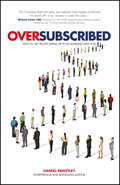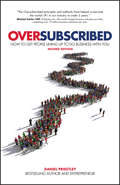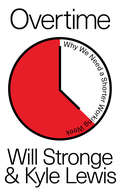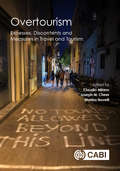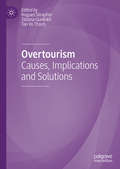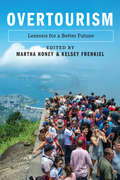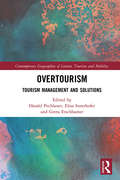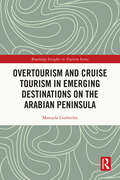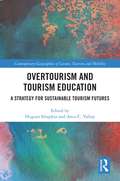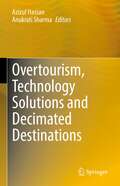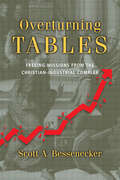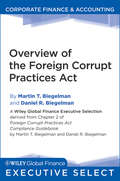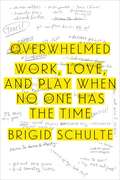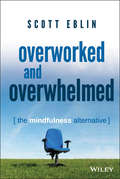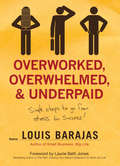- Table View
- List View
Oversight Systems
by Amram Migdal Frank V. CespedesThe case, set in May 2016, discusses sales strategy and managing sales and service at Oversight Systems, an Atlanta, Georgia-based software firm that developed analytics for organizations to monitor their data for errors, fraud, and operational inefficiencies. Included is an overview of Oversight's founding and the evolution of its offering from customized software analytics to pre-packaged software-as-a-service (SaaS) bundles, called Insights on Demand (IOD). Oversight adapted its sales and service approach to better suit IOD by standardizing its prices, packaging, and product delivery, as well as its approach to sales, including the sales team's composition, compensation, and incentive structure. Over time, Oversight had engaged in a variety of channel partnerships, and some were more successful than others. The case examines the decision of whether to engage in a channel partnership with a major credit card company.
Oversubscribed: How to Get People Lining Up to Do Business with You
by Daniel PriestleyDon't fight for customers, let them fight over you! Have you ever queued for a restaurant? Pre-ordered something months in advance? Fought for tickets that sell out in a day? Had a hairdresser with a six-month waiting list? There are people who don't chase clients, clients chase them. In a world of endless choices, why does this happen? Why do people queue up? Why do they pay more? Why will they book months in advance? Why are these people and products in such high demand? And how can you get a slice of that action? In Oversubscribed, entrepreneur and bestselling author Daniel Priestley explains why…and, most importantly, how. This book is a recipe for ensuring demand outstrips supply for your product or service, and you have scores of customers lining up to give you money. Oversubscribed: Shows leaders, marketers, and entrepreneurs how they can get customers queuing up to use their services and products while competitors are forced to fight for business Explains how to become oversubscribed, even in a crowded marketplace Is full of practical tips alongside inspiring examples to alter our mindsets and get us bursting with ideas Is written by a successful entrepreneur who's used these ideas to excel in the ventures he has launched
Oversubscribed: How To Get People Lining Up To Do Business With You
by Daniel PriestleyLearn how to get your business oversubscribed in a crowded marketplace to make your business stand out and get people lining up to do business with you Are you constantly chasing customers? Why does it seem like some businesses have their customers begging to purchase their goods or services? Think about it for a moment. When a new iPhone is released, why do customers camp overnight to be the first through the door? In cities with thousands of great restaurants, why do some restaurants require reservations months in advance? Why is it that some consultants, accountants, lawyers and healthcare professionals can charge exponentially more than others? In the modern marketplace, consumer options are virtually endless, intense competition is rife and so much is given away for free online. Often businesses are left scrambling to attract enough customers to make a small profit. Yet the opposite is true for a small number of businesses that do things differently—customers chase them. They have buyers who gladly queue up, pay more, and eagerly wait for the chance to hand over their money for the next thing. How do these businesses do it? More importantly, how can you become one of them? Oversubscribed is the guide to transforming your business into one which customers fight over! Author Daniel Priestley, a successful entrepreneur who has built and sold businesses around the world, shares proven, real-world methods that will not only grab customers’ attention, but will also have them lining up to buy from you. This invaluable guide will teach you how to drive demand for your products or services far beyond supply and will dramatically increase the success of your business. Now in its second edition, this updated version offers new insights and motivating examples that are right for the 2020s. This book will show you: The principles and philosophies Oversubscribed businesses live by that are often the opposite of what most businesses do Specific steps for getting into the mind of your customer so they only want to buy from your business How to structure campaigns and product launches that systematically get your business Oversubscribed How to implement a process of signalling to market, and collect signals back from market to build up desire and demand for your products and services The new edition of Oversubscribed: How to get people lining up to do business with you is a must-read for entrepreneurs, marketers, business leaders and owners, team managers, and business students.
Overtime: Why We Need A Shorter Working Week
by Will Stronge Kyle LewisWork isn&’t workingAs precarity and low pay become further embedded in the job market, at a time when work-related stress and exhaustion are endemic, it is clear that a new, radical approach to employment is required. Many industries already face existential threats from automation, climate breakdown, a crisis of care, and an ageing population. In Overtime, Kyle Lewis and Will Stronge identify a powerful and practicable response to these worrying trends: the shorter working week.This urgent and timely book shows what a shorter working week means in the context of capitalist economies and delves into the history of this idea as well as its political implications. Drawing on a range of political and economic thinkers, Lewis and Stronge argue that a shorter working week could build a more just and equitable society, one based on collective freedom and human potential, providing scope for the many to achieve a happier, more fulfilling life.
Overtourism: Excesses, Discontents and Measures in Travel and Tourism
by Daisuke Abe Dario Bertocchi Macià Blázquez-Salom Antonia Canosa Ernest Cañada Carlos Costa Margarida Ferreira Silva Roos Gerritsma Judy Kepher-Gona Anne Graham Jaume Gual-Carbonell Dimitri Ioannides Gunnar Thór Jóhannesson Jon Kohl Professor Katrín Anna Lund Ivan Murray Mathias Pecot Carla Ricaurte-Quijano Asunción Blanco-Romero Ivana Stevic Medéia Veríssimo Neiva Vieira Cunha Francesco Visentin Erica WilsonThis book examines the evolution of the phenomenon and explores the genesis of overtourism and the system dynamics underlining it. The 'overtourism' phenomenon is defined as the excessive growth of visitors leading to overcrowding and the consequential suffering of residents, due to temporary and often seasonal tourism peaks, that lead to permanent changes in lifestyles, amenities and well- being. Enormous tensions in overtourism affected destinations have driven the intensification of policy making and scholarly attention toward seeking antidotes to an issue that is considered paradoxical and problematic. Moving beyond the 'top 10 things you can do about overtourism', this book examines the evolution of the phenomenon and explores the genesis of overtourism as well as the system dynamics underpinning it. With a rigorous scientific approach, the book uses systems-thinking and contemporary paradigms around sustainable development, resilience planning and degrowth; while considering global economic, socio-political, environmental discourses. This book: - Deconstructs 'overtourism' and considers the many constituent parts that have led to its current conceptualisations; - Presents globally diverse views of overtourism through numerous case studies; - Is written in plain language accessible to readers beyond the academic context. Researchers, analysts, policy makers and industry stakeholders working within tourism as well as those within the private sector, community groups, civil society groups and NGOs will find this book an essential source of information.
Overtourism: Causes, Implications and Solutions
by Tatiana Gladkikh Hugues Séraphin Tan Vo ThanhThe term ‘overtourism’ has come into prominence since 2017 and refers to the fact that, due to various factors such as more sophisticated marketing strategies, a large number of tourists visit the same place at the same time. The consequences are felt by the locals, the tourists themselves as well as the environment. As a result, tourismphobia and anti-tourism movements have emerged as ways for locals to reclaim their lifestyle by refusing to interact with visitors and sometimes discouraging them to visit.This book presents new research on this emerging phenomenon and discusses the main causes and implications before putting forward possible solutions. The authors take an interpretivist approach in order to unveil aspects of overtourism that have not yet been discussed. It provides case studies and explores topics such as tourism education, overtourism of cultural and heritage sites, and the need for sustainable tourism development.
Overtourism: Lessons for a Better Future
by Dr Martha HoneyBefore COVID-19 hit, the biggest problem in the world of travel was overtourism. Crowds threatened to spoil natural environments and make daily life unbearable for residents of popular travel destinations. Then, seemingly overnight, tourism nearly ceased. Yet there is no question that travel will resume; the only question is, when it does, what will it look like? Will we return to a world of overrun monuments, littered beaches, and gridlocked city streets? Or can we do things differently this time?Overtourism: Lessons for a Better Future charts a path toward tourism that is not only sustainable but regenerative for the places we love and the people who live there. Bringing together tourism officials, city council members, travel journalists, consultants, scholars, and trade association members, this practical book explores overcrowding from a variety of perspectives. After examining the causes and effects of overtourism, it turns to management approaches in five distinct types of tourism destinations:1. historic cities;2. national parks and protected areas;3. World Heritage Sites;4. beaches and coastal communities; and5. destinations governed by regional and national authorities. While each location presents its own challenges, common mitigation strategies are emerging. Visitor education, traffic planning, and redirection to lesser-known sites are among the measures that can protect the economic benefit of tourism without overwhelming local communities.As tourism revives around the world, these innovations will guide government agencies, parks officials, site managers, civic groups, environmental NGOs, tourism operators, and others with a stake in protecting our most iconic places.
Overtourism: Tourism Management and Solutions (Contemporary Geographies of Leisure, Tourism and Mobility)
by Harold Pechlaner Elisa Innerhofer Greta ErschbamerOvertourism explores a growing phenomenon in tourism that is currently creating tensions in both urban and rural tourist destinations worldwide. This volume proposes a framework for a series of possible solutions and management strategies for dealing with overtourism and the various negative impacts that large quantities of tourists can impose. Questioning the causes of this phenomenon – such as increased prosperity and mobility, technological development, issues of security and stigma for certain parts of the world, and so on – this book supposes that better visitor management strategies and distribution of tourists can offset the negative impacts of overtourism. Individual chapters focus on a range of destinations including Venice, Barcelona and Dubrovnik, as well as UNESCO cultural and natural heritage sites, where local political actors and public authorities are not always able to deal with the situation effectively. Integrating research and practice, this book will be of great interest to upper-level students, researchers and academics in tourism, development studies, cultural studies and sustainability, as well as professionals in the field of tourism management.
Overtourism and Cruise Tourism in Emerging Destinations on the Arabian Peninsula (Routledge Insights in Tourism Series)
by Manuela GutberletCruise tourism is one of the fastest growing sectors worldwide. This book is the first of its kind to provide in-depth insights into the emergence of mega-cruise tourism in destinations on the Arabian Peninsula and its impacts on local communities, their spaces, cultures, identities and tourist experiences. It offers a micro-sociological analysis, calling for holistic, participatory, mindful approaches and to rethink current exploitative tourism planning and development. It assumes a high political, social and economic importance within globalization. It draws on a long-term field study in an under-researched region in Asia that developed large-scale tourism recently to diversify the economy. The book provides insights on the destination development from a state of continuous growth to a sudden fall in tourism activities due to a sudden shock, caused by the global health pandemic and its resilience. It explores the sociocultural, economic and spatial challenges faced in international tourism development and its power relations analysed from different perspectives and within time. It analyses time-space compression, overtourism, urban tourism, nature-based tourism, enclavization, social capital, imaginaries, Cultural Ecosystem Services, slow tourism as well as just tourism. The book provides an innovative contribution to the planning and development of tourism destinations, communities and their spaces in which tourism operates in a fast pace. It will be of interest to academics, undergraduate and postgraduate students in the field of tourism and hospitality management, geography, sociology, anthropology, urban planning and environmental sciences. Moreover, the book will be useful for practitioners and policymakers around the globe, as well as all those interested in the fast emergence and the impacts of mega-cruise tourism.
Overtourism and Tourism Education: A Strategy for Sustainable Tourism Futures (Contemporary Geographies of Leisure, Tourism and Mobility)
by Hugues Séraphin Anca C. YallopSince 2017, the term ‘overtourism’ has become the buzzword for destinations suffering the strain of tourism. It is a critical issue for the 21st century and beyond, and to date has only been examined from a tourism industry perspective. This book takes a different stand by investigating overtourism from a tourism education perspective. The recent global COVID-19 pandemic was expected to halt travel and, arguably, overtourism. However, industry experts and researchers share the opinion that instead of declining, overtourism is simply experiencing a shift, with a swarm of ‘second home’ and domestic travel that is likely to engulf many tourism destinations. Against this backdrop, the issue of overtourism remains relevant and studies on ways to cultivate responsible consumer mindsets to deal with overtourism and other sustainability issues in the tourism industry are called for. This book focuses on education as a transformative and strategic tool to tackle overtourism and related negative impacts. It presents original research on the topics of overtourism, education, and sustainability, and puts forward a range of practical and transformative tourism education strategies to mitigate overtourism and to promote the sustainable development of destinations. This book will be of great interest to upper-level students, researchers, and academics in tourism, development studies, cultural studies, and sustainability, as well as professionals in the field of tourism management.
Overtourism, Technology Solutions and Decimated Destinations
by Azizul Hassan Anukrati SharmaThis book meticulously focuses on seeing technological solutions of overtourism on decimated destinations from a comprehensive viewpoint. Considering the present crisis situation, the global tourism industry is in need to formulate revised strategies to recover and to be more resilient. The book creates a platform to deliberate the measures needed to be taken to tackle the issue of this most recent crisis of COVID-19 on the lens of overtourism and technology application. The book adds some unique suggestions to direct a new outlook towards overtourism, technology solutions and decimated destinations. This book discusses the responsibilities of tourists towards decimated destinations as well as provides in-deep knowledge and debates about technological solutions to overtourism in decimated destinations.
Overturning Tables: Freeing Missions from the Christian-Industrial Complex
by Scott A. Bessenecker12th Annual Outreach Resource of the Year Recommendation (Cross-Cultural)2014 Best World Missions Book, from Byron Borger, Hearts and Minds Bookstore
Overview: Making Innovation Pay
by Harold L. Sirkin James P. Andrew John ButmanFor almost every company, the greatest challenge of innovation is not a lack of ideas but rather, successfully managing innovation so that it delivers the required payback, or return on the company's investment of money, time, and people. This chapter introduces the concept of payback and summarizes three innovation business models and what it takes to align and lead for payback.
Overview of Project Finance--2004 Update
by Benjamin C. Esty Aldo SesiaIntroduces the field of project finance and provides a statistical overview of the project-financed investments over the last five years. Defines project finance and contrasts it with other well-known financing structures. Describes the evolution of project finance, from its beginnings in the natural resources industry in the 1970s to the U.S. power industry in the 1980s and to a much wider range of industry applications and geographic locations in the 1990s and 2000s. Provides a statistical overview of project-financed investments over the last five years (2000-2004), featuring industry, project, and participant data. Also discusses current and likely future trends and provides terminology and institutional details.
Overview of Project Finance and Infrastructure Finance---2006 Update
by Benjamin C. Esty Aldo SesiaProvides an introduction to the fields of project finance and infrastructure finance, and gives a statistical overview of project-financed investments over the years from 2002 to 2006. Examples of project-financed investments include the $4 billion Chad-Cameroon pipeline, $6 billion Iridium global satellite telecommunications system, $900 million A2 Toll Road in Poland, $1.4 billion Mozal aluminum smelter in Mozambique, and $20 billion Sakhalin II gas field in Russia. Globally, firms financed $328 billion of capital expenditures using project finance in 2006, up from $217 billion in 2001. The use of project finance has grown at a compound rate of 13% over the past 10 years. Focuses primarily on private sector investment in industrial and infrastructure projects, and contains four sections. The first section defines project finance and contrasts it with other well-known financing mechanisms. The second section describes the evolution of project finance from its beginnings in the natural resources industry in the 1970s, to the U.S. power industry in the 1980s, to a much wider range of industry applications and geographic locations in the 1990s, to infrastructure finance in the 2000s. The third section provides a statistical overview of project-financed investment over the last five years (2002 to 2006), and looks at industry, project, and participant specific data. In addition, provides recent data on infrastructure investments and public-private partnerships. The final section discusses current and likely future trends.
An Overview of Project Finance and Infrastructure Finance--2009 Update
by Benjamin C. Esty Aldo SesiaProvides an introduction to the fields of project finance and infrastructure finance, and gives a statistical overview of project-financed investments over the years from 2005 to 2009. Examples of project-financed investments include the $1.4 billion Mozal aluminum smelter in Mozambique, $4 billion Chad-Cameroon pipeline, $6 billion Iridium global satellite telecommunications system, 900 million A2 Toll Road in Poland, $20 billion Sakhalin II gas field in Russia, and the $28 billion Dabhol power project. Globally, firms financed $240 billion of capital expenditures using project finance in 2009, down from $409 billion in 2008 as the financial crisis hit the Western markets. The use of project finance has grown at a compound rate of 0% over the last five years, 4% over the past 10 years, and 12% over the past 15 years. This note focuses primarily on private sector investment in industrial and infrastructure projects, and contains four sections. The first section defines project finance and contrasts it with other well-known financing mechanisms. The second section describes the evolution of project finance from its beginnings in the natural resources industry in the 1970s, to the U.S. power industry in the 1980s, to a much wider range of industry applications and geographic locations in the 1990s, and most recently to infrastructure finance in the 2000s. The third section provides a statistical overview of project-financed investment over the last five years (2005 to 2009), and looks at industry, project, and participant specific data. The third section also provides recent data on infrastructure investments and public-private partnerships. The final section discusses current and likely future trends.
An Overview of Project Finance and Infrastructure Finance-2014 Update
by Benjamin C. Esty Aldo Sesia Carla ChavichProvides an introduction to the fields of project finance and infrastructure finance, and gives a statistical overview of project-financed investments over the years from 2009 to 2013. Examples of project-financed investments include the the Kashagan oil field development in Kazakhstan (1997), the $1 billion Port of Miami Tunnel (2007), the $54 billion Gorgon liquefied natural gas (LNG) project in Australia (2009), and the $6 billion Oyu Tolgoi copper mine expansion in Mongolia (2014). Globally, firms financed a record $415 billion of capital expenditures using project finance in 2013, and the use of project financed-investment has grown at a compound rate of 8% over the past 15 years despite several macroeconomic crises.This note focuses primarily on private sector investment in industrial and infrastructure projects and contains four sections. The first section defines project finance and contrasts it with other well-known financing mechanisms. The second section describes the evolution of project finance from its beginnings in the natural resources industry in the 1970s, to the U.S. power industry in the 1980s, to a much wider range of industry applications and geographic locations in the 1990s and 2000s, and most recently to infrastructure finance in the 2010s. The third section provides a statistical overview of project-financed investment over the last five years (2009 to 2013) and looks at industry, project, and participant specific data. The third section also provides recent data on infrastructure investments and public-private partnerships. The final section discusses current and likely future trends.
Overview of Senior Housing in the United States
by Joseph Beyer Charles F WuThis technical note provides an overview of the senior housing industry in the United States. There were 40 million seniors in America in 2010, and that number was expected to double by 2050. Seniors would make up 1 in every five Americans. This note explores the living options available to this important and fast-growing demographic.
An Overview of the "Employees First, Customers Second" Approach to Management-How Empowering Your Employees Sets the Stage for Transformative Growth
by Vineet NayarIf yours is a knowledge-based business, you know that your company's assets lie increasingly in the talent and creativity of your employees. Vineet Nayar, CEO of HCL Technologies, a global IT services company, draws on his own experience to show how a company can focus on its value creators-its frontline employees-to achieve remarkable growth and profitability through innovation. In this chapter, he describes how his company turned the conventional wisdom-that the customer always comes first-upside down. By putting employees first, writes Nayar, you can bring about a fundamental change in the way you deliver value to your customers and differentiate your company from its competitors. This is the story of one company's journey to transformation and accelerated growth, but it's one that can be adapted and applied in a thousand different ways-in any company, industry, or culture. This chapter was originally published as the Introduction of "Employees First, Customers Second: Turning Conventional Management Upside Down."
Overview of the Foreign Corrupt Practices Act (Wiley Global Finance Executive Select #5)
by Martin T. Biegelman Daniel R. BiegelmanThis extract is from chapter 2 in Foreign Corrupt Practices Act Compliance Guidebook, by Martin T. Biegelman and Daniel R. Biegelman. The focus is on an understanding of the Foreign Corrupt Practices Act (FCPA) statute, its enforcement policies and penalties, as well as important case law and the role of government. It is not just large, multinational companies that are violating the FCPA; it is also smaller, private companies and individuals who are employing questionable practices. This chapter provides an overview of the statute and how it is applied to best ensure compliance.
Overview of the Project Finance Market
by Benjamin C. Esty Suzie Harris Kathy KruegerThis case introduces the field of project finance and supplies a statistical overview of the project finance market as of the mid=to late 1990s. It consists of four sections. The first section defines project finance and contrasts it with other well-known forms of financing. The second section describes the evolution of project finance from its origins in the 13th century in the mining industry, to the U.S. electric power industry in the 1970s and 1980s, and then to a much wider range of applications and locations in the 1990s. The third section provides a statistical overview of the project finance market as it exists today in terms of industry, project, and participant data. The final section discusses current and likely future trends. There is also an appendix that describes sources of industry data and other project finance information.
Overwhelmed: Work, Love, and Play When No One Has the Time
by Brigid SchulteAccording to the Leisure Studies Department at the University of Iowa, true leisure is “that place in which we realize our humanity.” If that’s true, argues Brigid Schulte, then we're doing dangerously little realizing of our humanity. In Overwhelmed, Schulte, a staff writer for The Washington Post, asks: Are our brains, our partners, our culture, and our bosses making it impossible for us to experience anything but “contaminated time”?<P> Schulte first asked this question in a 2010 feature for The Washington Post Magazine: “How did researchers compile this statistic that said we were rolling in leisure—over four hours a day? Did any of us feel that we actually had downtime? Was there anything useful in their research—anything we could do?”<P> Overwhelmed is a map of the stresses that have ripped our leisure to shreds, and a look at how to put the pieces back together. Schulte speaks to neuroscientists, sociologists, and hundreds of working parents to tease out the factors contributing to our collective sense of being overwhelmed, seeking insights, answers, and inspiration. She investigates progressive offices trying to invent a new kind of workplace; she travels across Europe to get a sense of how other countries accommodate working parents; she finds younger couples who claim to have figured out an ideal division of chores, childcare, and meaningful paid work. Overwhelmed is the story of what she found out.
Overworked and Overwhelmed: The Mindfulness Alternative
by Scott EblinLeverage mindful awareness and intention to achieve better outcomes Overworked and Overwhelmed: The Mindfulness Alternative offers practical insights for the executive, manager or professional who feels like their RPM is maxed out in the red zone. By making the concepts and practices of mindfulness simple, practical and applicable, this book offers actionable hope for today's overworked and overwhelmed professional. New research shows that the smartphone equipped professional is connected to work 72 hours a week. Forty eight percent of Americans report that their stress level is up and that the number one source of stress is the job pressure of a 24/7 world. What's the alternative? Top leadership coach and educator Scott Eblin offers one in Overworked and Overwhelmed: The Mindfulness Alternative. While mindfulness is one of the "Top Ten Trends for 2014 and Beyond," many professionals think it's just too hard to give it a try. In this book, Eblin shows that mindfulness that makes a difference doesn't require meditating like a Buddhist monk. Overworked and Overwhelmed is a handbook for more mindful work and living that offers: "Must know" mindfulness basics that today's professional needs to thrive in a 24/7 world. Inspiring examples of mindfulness in action from dozens of leaders ranging from a U.S. Coast Guard Commandant to the CEO of Hilton Worldwide. A self assessment for readers to understand how they perform at their best. Simple routines to reduce stress and sustain peak performance. A personal planning framework for creating the outcomes that matter most at home, at work and in the community. Even small increases in mindfulness can lead to big changes in productivity and quality of life for the overworked and overwhelmed professional. Overworked and Overwhelmed: The Mindfulness Alternative is a guide for doing just that.
Overworked, Overwhelmed, and Underpaid
by Louis BarajasWorking people of every conceivable age, sex, marital status, career path, tax bracket, and length of employment have at least one thing in common--they all feel OVERWORKED, OVERWHELMED & UNDERPAID. But they can fix it. AND YOU CAN FIX IT TOO.Every day financial planning expert Louis Barajas teaches CEOs and blue-collar workers alike how to make the most of their lives. Now he introduces you to his straightforward and proven plan, complete with simple and creative exercises, to help you go from: OVERWORKED. . .to living a balanced life OVERWHELMED. . .to being relaxed and in control UNDERPAID. . .to doing well through meaningful workIn other words, he shows you how to go from STRESS to SUCCESS.Louis' goal is to create an economic revolution for the working class, enabling you to attain greater abundance through more thoughtful, purposeful, and rewarding financial choices.

